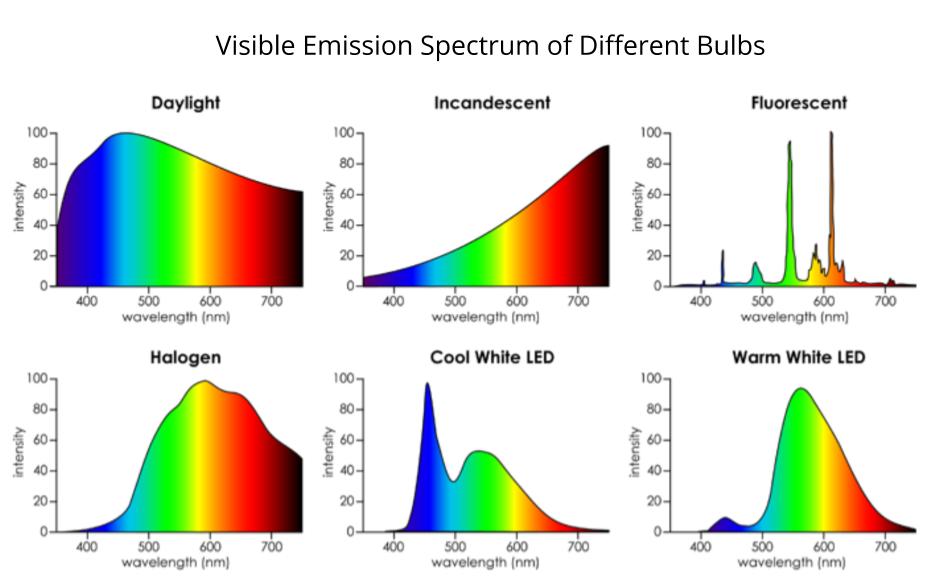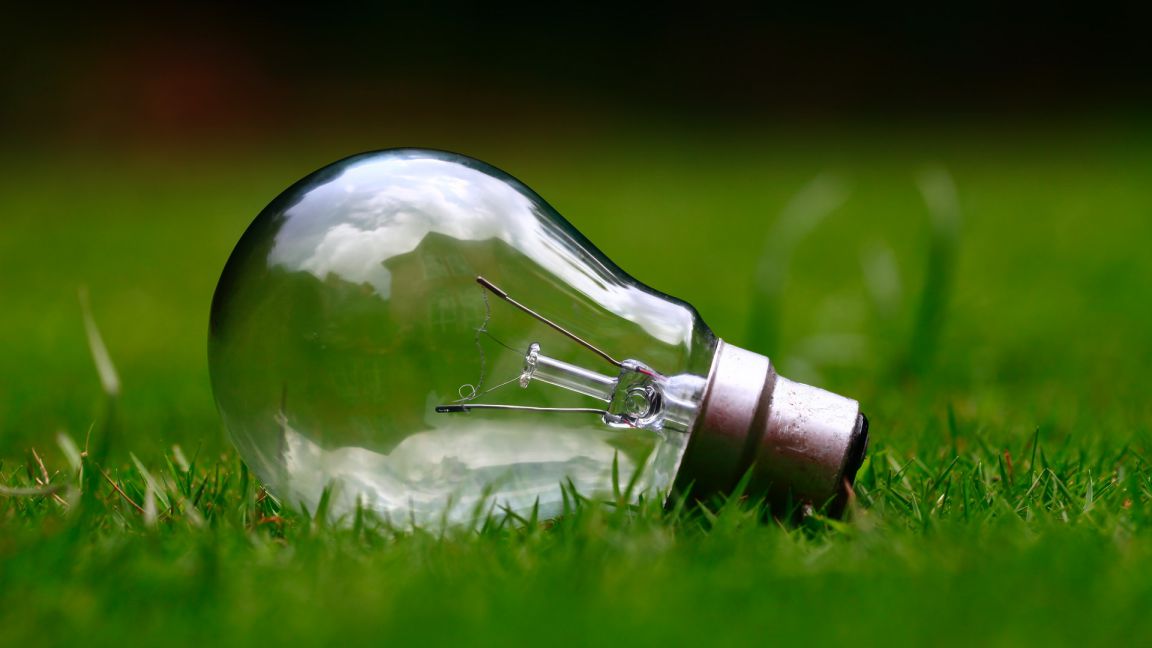Electric light became available in homes less than 150 years ago. It is a relatively new phenomenon to light our spaces beyond the natural light and dark cycles that our bodies have evolved to live with. The incandescent light bulb was the first bulb that became available for widespread use, in the 1880s. This light bulb was the primary option for over 100 years until the CFL (compact fluorescent bulb) was introduced in the ’90s. Over the last 10 years, the energy-efficient LED bulb has become the main choice for use in homes. Making healthier home lighting choices can greatly influence our overall health.
Light is a Spectrum of Colours
Light is a visible spectrum, consisting of different wavelengths or colors. Different types of light bulbs emit different wavelengths of light, giving bulbs a different color temperature. Sunlight offers a smooth and continuous emission spectrum and doesn’t leave any wavelengths out. Morning and evening sunlight emits high red and yellow wavelengths and low blue. Whereas the midday sun is rich in blue light and low in red and yellow. This natural distribution of wavelengths is important to our health.
Colour Temperature of Bulbs
The temperature of a bulb measures how we perceive that color, as either cool or warm. It is measured in Kelvin (K) and most bulbs usually range from 2000K to 5000K. The higher the temperature, the more “cool” and “white” the light appears. This means these lights are emitting primarily blue light. The lower the temperature, the “warmer” the light appears, with more yellow and orange wavelengths of light. Noontime sun has a color temperature of around 5500K.
Health Issues with Bulbs
Excess Blue Light
Blue light has a shorter wavelength and because of this, more energy. It penetrates through the eye’s cornea and into the retina more easily, increasing stress and damage. Our screens and LED bulbs are bathing us in more blue light than ever. These high levels of blue light send a message to your body that it is midday and they should be alert. This halts production of melatonin, affecting your ability to sleep properly. Too much blue light has also been linked to other issues, such as macular degeneration. Wearing blue blocking glasses once the sun sets is a great strategy (Example 1, Example 2).
Flicker
Flicker refers to the rapid and repeated change in brightness of a bulb. This happens so quickly we usually can’t perceive it. Fluorescent bulbs tend to flicker bright to dim. With LED’s, it is typically a bright to dark flickering. These flickers also range in speed of repetition, or frequency. The lower the flicker, the more perceptible and damaging (e.g., seizure inducing). Health effects have been found for both visible and invisible flicker rates, especially under 200Hz (cycles per second).
3 Most Popular Bulb Types
Incandescent – The Healthiest Bulb
The colours of light we are exposed to, and at what time of day, is important to our health. During dawn and dusk our bodies do best with red and yellow wavelengths, because this is what the sun does at these times of day. Incandescent light bulbs emit light which is higher in these more desirable wavelengths of red and yellow. Keeping this in mind, lighting the areas that we spend time at night in, with incandescent bulbs, is a healthier choice. Unfortunately, many governments have made the sale of incandescent bulbs illegal, due to their higher energy demand. However, if using consciously, in strategic locations, they are a great healthy home lighting strategy.
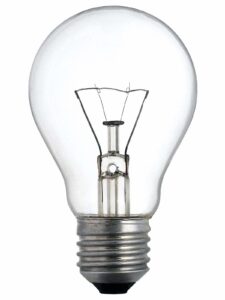
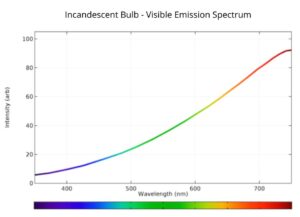
CFL (Compact Fluorescent Bulb)
These are compact, bent versions of the long fluorescent tubes that we see in so many office buildings. They have a longer lifespan than incandescent bulbs, however their energy efficiency is the only improvement. There are many shortcomings with the CFL bulb. Their emission spectrum is not nearly as even as incandescent bulbs (see below). Fluorescent bulbs always have an uneven colour distribution, with narrow peaks at different wavelengths. They also produce a flicker and elevated levels of EMF’s. Another harmful aspect of CFL bulbs is their high levels of mercury. A typical CFL bulb contains 1.5 – 5 mg of mercury (those old thermometers had between 0.3 – 5 mg). This toxic gas gets released into the air when they break. Leaving the room and airing it out for 10 minutes before cleaning is very important. Read more about how to clean up a broken CFL bulb here.
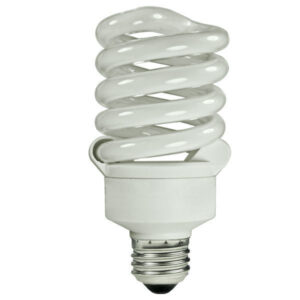
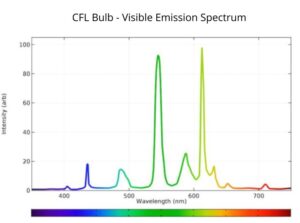
LED (Light Emitting Diodes)
LED lighting has become the most popular type of lightbulb used in homes.This is an impressive feat considering it was only in 2010 that the first LED bulb, designed to replace the incandescent and CFL bulb, became commercially available. As the effects of LED lighting continue to be understood and improved upon, quality is increasing.
Currently, there is large variation in type and quality of parts used in LED bulbs. It is possible to create a white LED which comes close to simulating sunlight with a good distribution of wavelengths and no flicker. However, the vast majority of LED’s are not a healthy choice. They tend to flicker from bright to dark, and they contain a list of toxic substances such as lead and arsenic. If you break an LED bulb, it is recommended that you air out the room and clean up with gloves and a broom, throwing out both when done. LED bulbs are often much higher in blue light and lower in red and yellow. This profile makes them fine for midday, but not suitable for use at nighttime. The more “white” the LED is, the more blue light it is emitting. Checking the colour temperature of the bulb you are buying is important. Look for bulbs with ratings of 2700K and lower, and ideally no flicker.
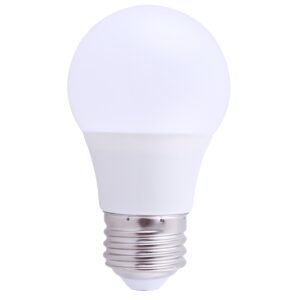
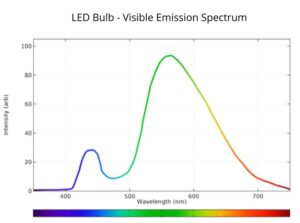
Bulb Comparisons
Incandescent bulbs remain the healthiest option for the home. They do not flicker, have a much healthier distribution of colour, and contain less toxic materials. Using them where you spend time at night is a great strategy. If you use screens, or have LED lighting in your nighttime areas, wearing blue-blocking glasses can dramatically improve your eye health, energy and sleeping patterns.
